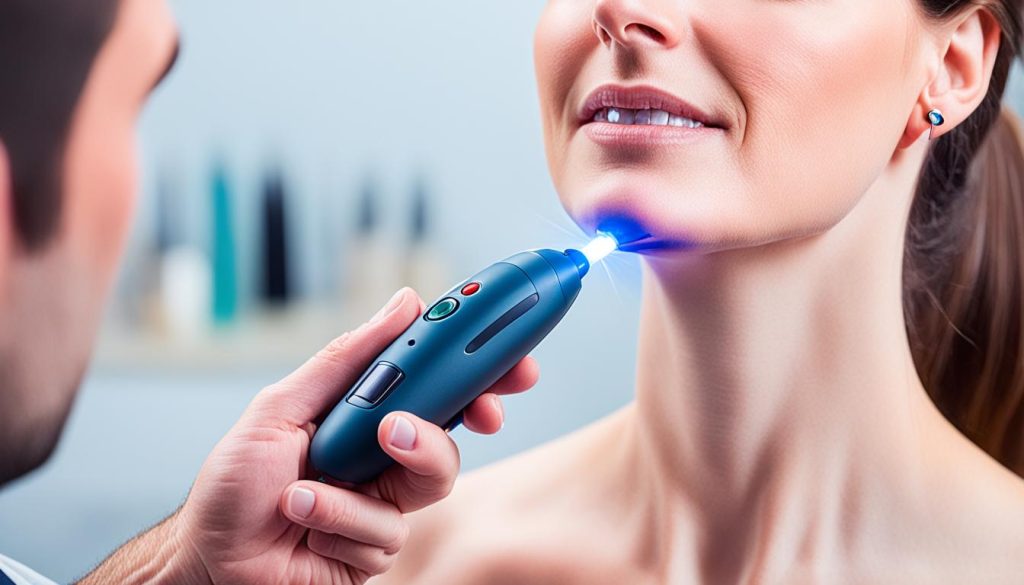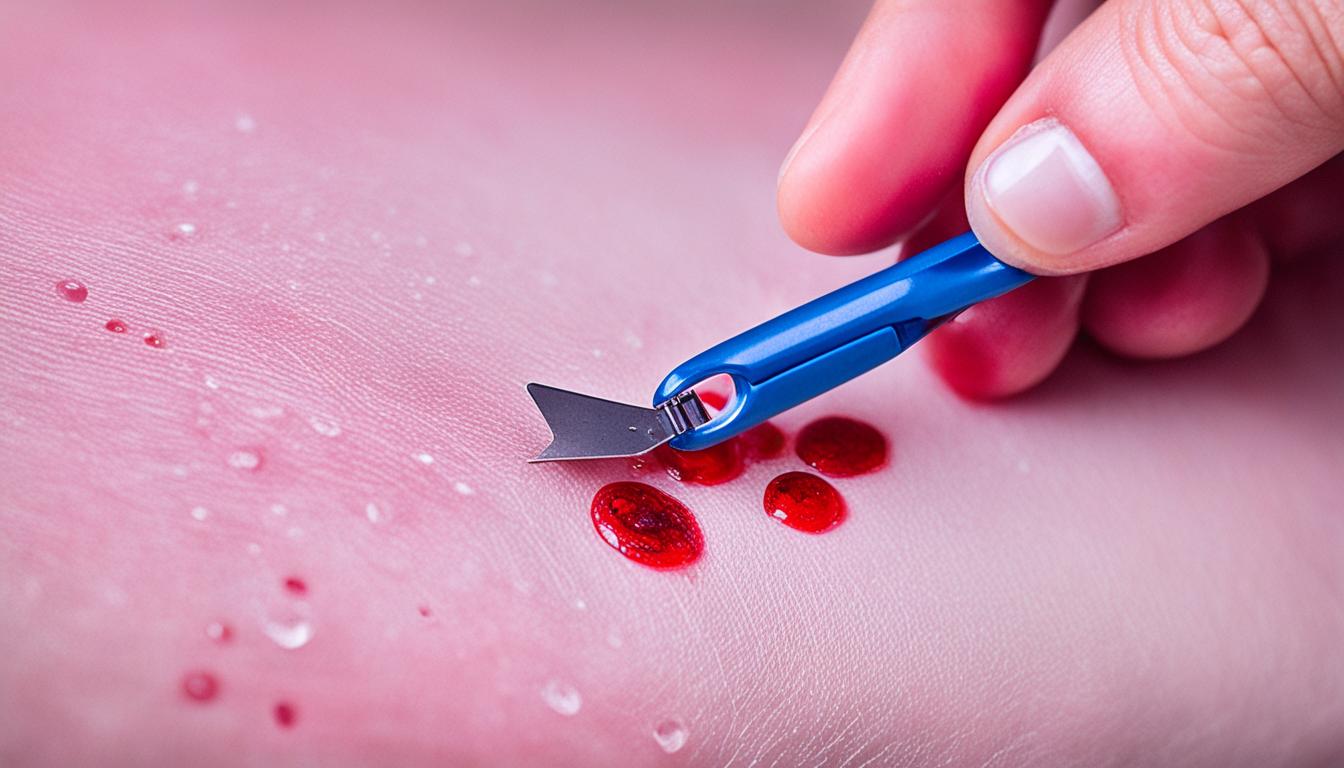Skin tags are common, harmless growths that can be bothersome for some individuals. While they do not require treatment and may fall off on their own, there are various methods available for removing skin tags. It is important to consult with a doctor before attempting any removal techniques at home. This article will provide safe and effective tips for skin tag removal.
What are Skin Tags and Their Causes?
Skin tags, also known as acrochordons, are soft, harmless growths that commonly occur in areas where the skin rubs together. These small, flesh-colored or slightly darker skin outgrowths are typically found on the neck, armpits, groin, and eyelids. While skin tags are generally painless and benign, they can be a source of discomfort or self-consciousness for some individuals.
The exact cause of skin tags is unknown, but theories suggest that skin irritation and friction may contribute to their formation. When skin rubs against skin, such as in areas where there are skin folds or creases, it can lead to the development of skin tags. The friction and constant rubbing cause the surface layers of skin to fold and form a small flap or tag. It is believed that both genetic and environmental factors contribute to the development of skin tags.
While anyone can develop skin tags, certain factors may increase the risk of their occurrence. Obesity, for example, is associated with a higher prevalence of skin tags due to the increased friction and skin fold formation. Similarly, individuals with diabetes or those who are pregnant may be more prone to developing skin tags. Hormonal changes that occur during pregnancy or due to hormonal imbalances can also contribute to their development.
It is important to note that skin tags do not go away on their own. Once they appear, they tend to persist unless removed. However, skin tags are harmless and benign, requiring treatment only if they cause discomfort or cosmetic concerns. While self-care measures may help alleviate symptoms or prevent further irritation, consulting with a healthcare professional is recommended for appropriate diagnosis and treatment options.

| Symptoms of Skin Tags | Skin Tag Causes | Do Skin Tags Go Away? |
|---|---|---|
|
|
|
How to Get Rid of Skin Tags?
Home Remedies for Skin Tag Removal
Removing skin tags at home can be a safe and cost-effective option for those looking to get rid of these bothersome growths. There are several natural remedies that may help in the process of skin tag removal. While these remedies may take time to produce results, they can be effective and convenient for many individuals.
Tea Tree Oil
One popular natural remedy for skin tag removal is tea tree oil. Known for its antimicrobial and anti-inflammatory properties, tea tree oil can help dry out the skin tag and eventually lead to its removal. To use tea tree oil, simply apply a few drops onto a cotton ball and gently dab it onto the skin tag. Repeat this process multiple times a day until the skin tag disappears.
Banana Peel
Another surprising home remedy for skin tag removal is banana peel. The enzymes present in banana peels can help break down the skin tag tissue. To use this method, cut a small piece of banana peel and place it on the skin tag. Secure it with a bandage and leave it overnight. Repeat this process for several nights until the skin tag falls off.
Apple Cider Vinegar
Apple cider vinegar is a common household ingredient that is also used for skin tag removal. It has acidic properties that can help dry out the skin tag and cause it to fall off. Simply soak a cotton ball in apple cider vinegar and apply it to the skin tag. Leave it on for a few minutes and then rinse off with water. Repeat this process several times a day until the skin tag disappears.
Vitamin E Oil
Vitamin E oil is known for its antioxidant properties and is often used in skincare. It can also be effective in removing skin tags. Gently massage a few drops of vitamin E oil onto the skin tag and leave it on overnight. Repeat this process daily until the skin tag is gone.
Garlic
Garlic is renowned for its medicinal properties and can also be used for skin tag removal. Crush a garlic clove to release its juices and apply it directly onto the skin tag. Cover it with a bandage and leave it on overnight. Continue this process daily until the skin tag disappears.

It is important to note that these home remedies may take time to show results. Consistency is key when using natural remedies for skin tag removal. Additionally, it is always advisable to consult with a healthcare professional before attempting any home removal techniques, especially if you have any underlying skin conditions or allergies.
Over-the-Counter Products for Skin Tag Removal
When it comes to removing skin tags, there are over-the-counter products available that can help. These products provide a convenient and cost-effective option for those looking to remove skin tags at home. Two common types of over-the-counter products for skin tag removal are freezing kits and removal creams.
Freezing Kits
Freezing kits are a popular choice for removing skin tags. They use a technique called cryotherapy, which involves freezing the skin tag to destroy it. The kit typically contains a freezing agent, such as liquid nitrogen, that is applied to the skin tag. This freezes the tag, causing it to fall off over time.
Removal Creams
Removal creams are another commonly used option for skin tag removal. These creams contain ingredients that work to break down the skin tag, gradually causing it to dry out and fall off. It is important to carefully follow the instructions provided with the cream and avoid any ingredients that may cause skin irritation.
Using over-the-counter products for skin tag removal can be an effective and convenient solution. However, it is advisable to consult with a healthcare professional before using any such products. They can provide guidance on choosing the right product and ensure it is safe for your specific skin type and condition.

| Pros of Over-the-Counter Products | Cons of Over-the-Counter Products |
|---|---|
| Convenient and accessible | Potential for skin irritation |
| Cost-effective compared to medical procedures | May take longer to see results than other methods |
| No need for a doctor’s appointment | Efficacy may vary depending on the individual |
Medical Procedures for Skin Tag Removal
In cases where home remedies and over-the-counter products are ineffective, medical procedures may be necessary for skin tag removal. Healthcare professionals utilize various methods to remove skin tags. Some commonly used medical procedures for skin tag removal include:
- Radiocautery
- Cauterization
- Cryotherapy
- Electrocautery
- Ligation
- Excision
These procedures are carried out by trained professionals and are performed in a clinical setting to ensure safe and effective removal of skin tags.
It is important to note that skin tag removal is considered a cosmetic procedure and is typically not covered by health insurance. The cost of skin tag removal varies depending on the method used and the healthcare provider.
| Method | Procedure | Cost |
|---|---|---|
| Radiocautery | The use of high-frequency radio waves to heat and remove the skin tag. | £150-£500 |
| Cauterization | The use of a heated instrument to burn and remove the skin tag. | £200-£600 |
| Cryotherapy | The application of extreme cold to freeze and destroy the skin tag. | £100-£300 |
| Electrocautery | The use of an electrical current to burn and remove the skin tag. | £200-£500 |
| Ligation | Tying off the blood supply to the skin tag, causing it to fall off. | £100-£300 |
| Excision | Surgical removal of the skin tag using a scalpel or surgical scissors. | £300-£800 |
It is recommended to consult with a healthcare professional to determine the most suitable method for skin tag removal and to obtain an accurate cost estimate based on individual circumstances.

Conclusion
Skin tags are a common occurrence and can be safely and effectively removed. While there are various home remedies and over-the-counter products available for skin tag removal, it is important to consult with a healthcare professional before attempting any removal techniques. In some cases, medical procedures may be necessary to remove skin tags. Understanding the causes of skin tags and taking preventive measures can help minimize their occurrence. If you notice skin tags suddenly appearing or any changes in their appearance, it is advisable to seek medical attention.
Why am I getting skin tags all of a sudden? Skin tags can develop due to various factors such as skin irritation, friction, obesity, diabetes, pregnancy, and hormonal changes. However, the exact cause of skin tags is still unknown. It is important to remember that while skin tags may be bothersome, they are usually harmless and can be easily removed.
Remember to approach any skin tag removal techniques with caution and seek professional advice. By staying informed about skin tag causes and prevention, you can take control of your skincare and well-being.
FAQs
Do skin tags go away on their own?
Skin tags do not go away on their own, but they can be easily removed.
What medical procedures are available for skin tag removal?
Medical procedures for skin tag removal include radiocautery, cauterization, cryotherapy, electrocautery, ligation, and excision. It is important to note that skin tag removal is typically considered a cosmetic procedure and may not be covered by health insurance.
Why am I getting skin tags all of a sudden?
The sudden appearance of skin tags may be due to factors such as skin irritation, hormonal changes, obesity, or other underlying health conditions. It is advisable to seek medical attention if skin tags suddenly appear or if there are any changes in their appearance.

